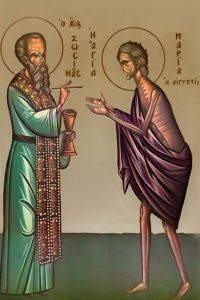
The fifth Sunday of Lent is the Sunday of St Mary of Egypt.
Click here for the text of Vespers, Orthros, and the Divine Liturgy variables.
Click here for the Typica service. (When reading Typica instead of attending Liturgy, you will need both the Typica and Divine Liturgy texts.)
Lenten Sunday Vespers is here.
Theme
On the Fifth Sunday of Lent the Orthodox Church commemorates our Righteous Mother Mary of Egypt. The feast day of Saint Mary of Egypt is April 1, however, she is also commemorated on this Sunday due to her recognition by the Church as a model of repentance.
Observance of the Week
The feast day of Saint Mary of Egypt is April 1, the day of her repose, however the Orthodox Church also commemorates the Saint on the Fifth Sunday of Lent. As a Sunday of Great Lent, the commemoration is celebrated with the Divine Liturgy of Saint Basil the Great, which is preceded by a Matins (Orthros) service. A Great Vespers is conducted on Saturday evening.
Saint Mary of Egypt is also commemorated on the Thursday before the Fifth Sunday of Lent, when her life is read during the Great Canon of Saint Andrew of Crete. A canon in her honor is read at the end of each Ode. In parish churches the service and the canon is most often conducted on Wednesday evening.
Story
Once, during the Honorable Fast, the priest-monk Zosimus withdrew into the wilderness. He caught sight of a withered woman named Mary; her hair was white as snow. Mary then told Zosimus that she was born in Egypt and at the age of 12 began to live a life of debauchery in Alexandria for 17 years. One day, she went to Jerusalem to enter the church to venerate the Honorable Cross. However, some invisible force restrained her. In great fear, she gazed upon the icon of the Theotokos in the vestibule and prayed that she be allowed to enter the church, all the while confessing her sinfulness. She was then permitted to enter the church. Having venerated the Cross she again entered the vestibule and, before the icon, gave thanks to the Mother of God. At that very moment she heard a voice saying: “If you cross the Jordan, you will find glorious rest!” Mary left for the wilderness and remained there for 47 years in repentance. She bade Zosimus to come back in one year with Holy Communion, which he did. The following year, on Holy Thursday, April 1, 522, Zosimus discovered Mary’s lifeless body, and buried her. Thus, the Lord glorifies penitent sinners. The Church exalts and exemplifies Mary to the faithful in Great Lent as an incentive for repentance that brings entry into the Heavenly Kingdom.